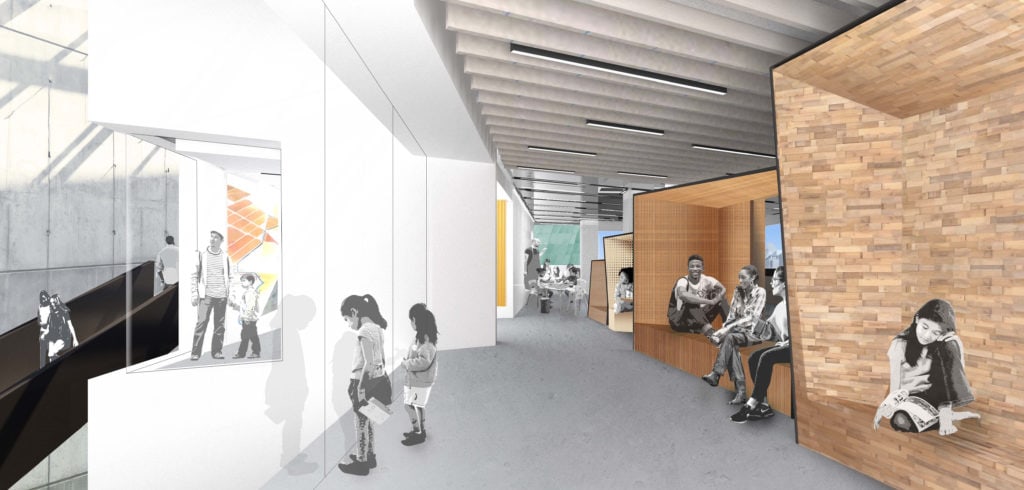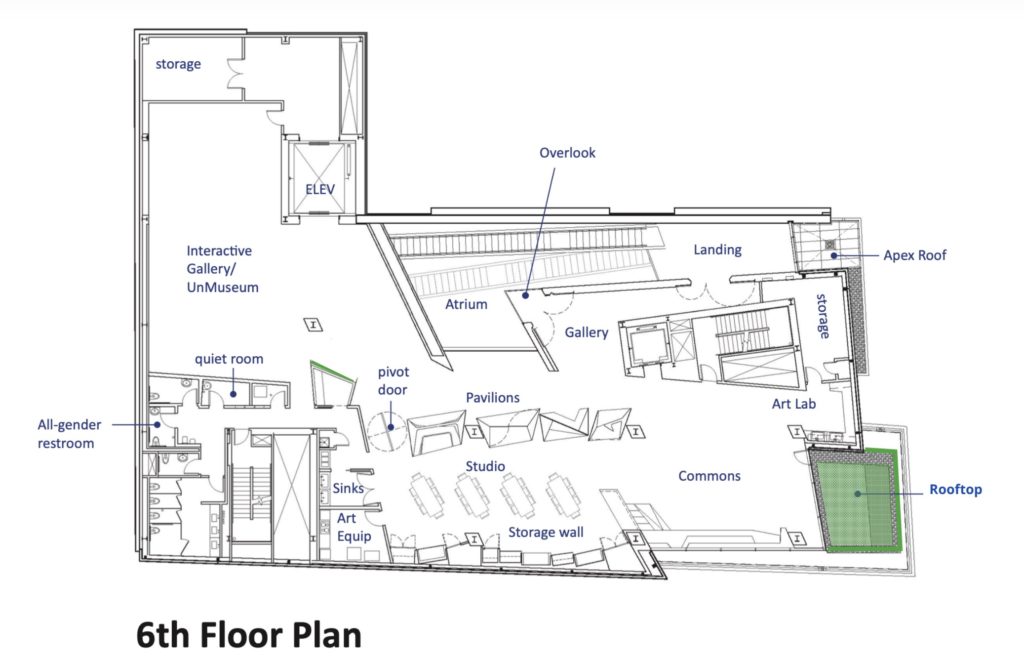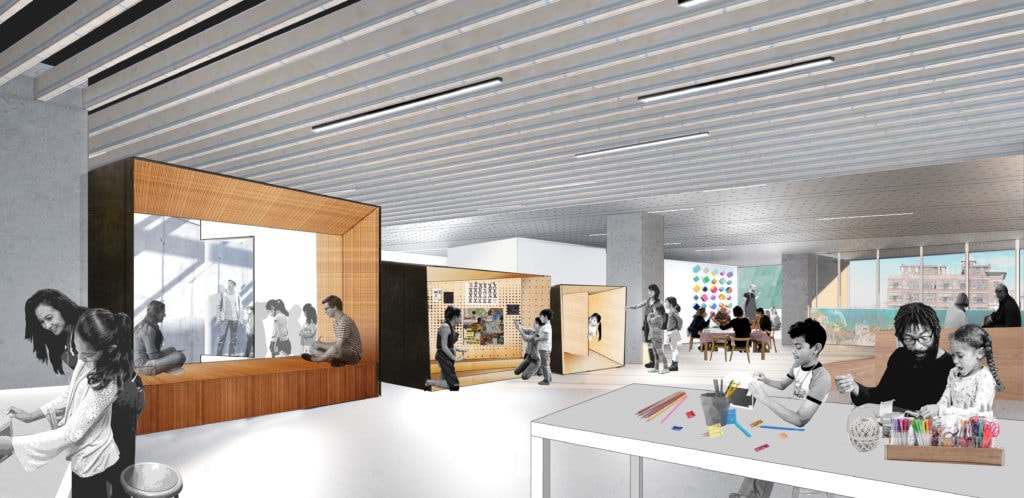Writer, aeqai
A new horizon opens at the Contemporary Arts Center, 44 E. Sixth Street, on Oct. 8 after seven years of planning. Begun in 2021, construction for a new Creativity Center will be finished in late August. During September, staff will install nine works of art.
“We needed a bigger space and to let people know they’re valued,” said Elizabeth Hardin-Klink, creative learning director.
To plan for the center, staff met with focus groups, surveyed the community, toured other museum education spaces, consulted with local educators and community members to decide what needs the CAC wanted the Creativity Center to meet.
Staff interviewed multiple architectural firms for the center including smaller firms. Hardin-Klink said, “Mir Collective from Chicago understood us and wanted to create respect for the building. Their designs showed well.”
Principal architect Kara Boyd said, “Both the iconic architecture by (now deceased) Zaha Hadid and the mission of the CAC are driven by the impetus to connect art and civic life. We envision the new Creativity Center as the physical nexus of the CAC’s social ecosystem that reaches far beyond the galleries. We wanted every surface and gesture to enhance connectivity in some way.”
“Our solution was to organize the sixth floor into dedicated areas for art, making and engagement by creating a spine of micro-spaces for art, making and engagement,” Boyd said. “Coupled with that, we designed new openings in the existing building to make the space feel more connected to the arts center, the city and the outdoors, and to expand indoor and outdoor exhibit space.”

Boyd said that the new center will help CAC expand and strengthen their programming and reach. “It will provide a physical home (that they never had) for their educational programming, and it will improve their curatorial options to exhibit,” she added.

Interim Director Marcus Margeron said, “The new Creativity Center will allow the CAC to better serve our metro-Cincinnati students, young adults and business community with various programs that promote the arts and the creative process.”
“Our brain trains us to think less creatively as we age,” Hardin-Klink added. “We wanted to try something new and embrace the risk.”
COVID put plans on hold. The illness made things tricky, according to Hardin-Klink. The staff had to deal with delays in supply orders and back orders.
As a result, the education team held programs onsite in the lobby, galleries, Black Box and lower level. Offsite, “We have been visiting parks and libraries. We’ve been using wagons and carts to move our supplies to each location,” said Hardin-Klink.“We haven’t made the UnMuseum™ available during this time,” she said.
When it is open, the Sara M. and Patricia A. Vance UnMuseum™ is a gallery of participatory art designed to offer visitors an enjoyable experience with the most innovative art of our time, according to Hardin-Klink. “It reaches far beyond traditional gallery guides and learning stations and instead commissions community artists to design artworks made for interaction. Unlike a traditional museum gallery, visitors learn through participating, touching and playing with each piece, all made by local contemporary artists. The UnMuseum™ did make up the entire sixth floor, however, it will now exist as an important part of the Creativity Center” said Hardin-Klink.
The center put out a call to artists, received many applicants and is now working with eleven artists on nine works of art. Karla Batres Gilvin and Bradly Gilvin make up the artist duo Batres Gilvin. They are partnering on the Community Connectivity quilt. Michelle D’Cruz and Christopher Glenn are working together on Flight of Fancy.
Other artists include Anissa Lewis, community mural at the entrance of the Creativity Center; Garrett Goben, Soft Bones; and Terence Hammonds, The Funk is Within You. There is a mix of ages and experience in the demographics of the artists who will continue the vision of interactive art. Other artists are Karen Saunders and Pam Kravetz, Buoyant; Julia Lipovsky, Community Mural; Abby Peitsmeyer, a student at the Art Academy of Cincinnnati, Land of Pasta-bilities.
Hardin-Klink said, “Nothing is permanent. Art created by the artists could be at the center anywhere from one to three years.” Some of the art will be for sale or could go to a library or school for display.

Turnbull-Wahlert Construction Company of Mariemont is the general contractor. Justin Brinker, project manager, said, “It has been fun to figure out new walls and ceilings in the existing space. Since the architecture has geometry, it is more complicated to put together.”
The Creativity Center will include several parts, some of which are listed below. Hardin-Klink provided this information.
There will be a sustainable art lab where recycling, up-cycling and other forms of zero-waste materials can be used for visitors to experiment and create works of art.
In addition, a large studio will host intergenerational creative programs using analog and digital tools for experiments. Visitors of all ages, including school groups, families, teens and adults can use this space.
A set of pavilions will offer a series of work niches available for creation, observation or gallery reflection.
A unique addition is the Commons, which provides a town square for art conversation with city skyline views.
Another feature of the Creativity Center is a changing community gallery dedicated to celebrating the creativity of CAC visitors of all ages by inviting them to display their own work, according to Hardin-Klink. Community artists, CAC educators and the CAC Teen Council will curate the space.
To prepare for tours, the center will have a docent lounge where volunteers can spend time on research work and have access to gallery learning resources.
In the midst of all this activity, there will be a quiet room – a space for visitors who seek a calm location.
The center will also offer a variety of programs, some of which are already in existence, but may be expanded with the new space. The call for community programs will occur in October once center staff is comfortable in the new space, according to Hardin-Klink. “Right now, our focus is on sixth floor construction and working with UnMuseum™ artists to curate and install their artwork,” she added.
One example is monthly family festivals tied to CAC exhibits. They may include artist-led projects, performances, STEAM-inspired making and special guests from local nonprofit organizations. Anywhere from 200 to 800 visitors attend family festival events. In spring the attendance is lower, and in winter there are more guests.
CAC will also offer Thursday Art Play, a weekly program using hands-on art making activities, creative play and yoga to excite and educate young visitors, according to Hardin-Klink.
Teen programs continue with a Contemporary Young Adults (C-YA) program that provides a year-long, arts focused experience to a select group of students, according to Hardin-Klink.
“C-YA Teen Council includes monthly career-focused workshops, followed by committee meetings that focus on providing teen created events, wall text and social media promotion. Council members host the CAC’s annual Art Prom and take a field trip to Chicago to meet with other museum teen councils,” she added. The center holds over 175 teen programs every year and has done so since it received an Institute of Museum and Library Services grant.
Public programs are available for all ages. “These include artist-in-residence, a bi-weekly program which is a collaboration that invites a select group of artists to engage with visitors through collaborative art making,” said Hardin-Klink.
Also, there are open studio hours, “a bi-weekly program that allows visitors of all ages to drop by CAC’s studio for open-ended making time.”
Adult programs feature CO-LAB, an experiment in what is possible. “This public laboratory invites artists and creatives to collaborate with CAC on community-based projects that alter perspectives, ignite change and engage the city,” according to Hardin-Klink.
If someone wants to learn a new craft, CAC will offer a monthly do-it-yourself workshop in a social atmosphere.
In addition to art, CAC sponsors the Creative Writing Project, “a series of workshops designed to provide adult writers of all levels with opportunities to explore the art of creative writing,” said Hardin-Klink. Experienced writers and educators will offer instruction and guidance.
Under the category of school programs, there are several offerings. “The CAC School Outreach Program provides an intensive multi-layered experience with contemporary art for students in second through twelfth grades,” said Hardin-Klink. It includes an in-school orientation, two guided visits to CAC exhibits, a classroom project taught by a local artist and a visit to an artist’s studio in the spring.
Homeschool Wednesdays is a monthly program designed for homeschool families. “Students receive a private exhibition tour, participate in hands-on art and science activities and receive resources for building on what they discovered,” said Hardin-Klink.
Boyd said Mir was impressed by CAC as a “top-tiered arts organization that has also intentionally taken on a role of meaningful community leadership. They advocate for inclusion, education, awareness and connection within the works and programs in their space and their outreach outside of CAC itself.”
Boyd added “We were also drawn to the way the CAC uses and encourages artists to use the building in dialogue with the art. The building is an amazing piece of architecture. It is a rare and coveted opportunity to design something within it.” One of CAC’s goals was to make this space feel truly welcoming to all, so it was important to make this space feel that way, according to Boyd.
“Working within the geometry of the building itself was a challenge, as well as an opportunity,” said Boyd. “Ultimately, pandemic repercussions were the biggest obstacle. They’ve caused significant delays, supply chain issues and inflation. We have made many things work, but some things had to be cut out for the increased costs to overcome those challenges.”
Admission to the CAC is free of charge thanks to the Johnson Foundation and a CAC patron group called “The 50” who committed to subsidize admission,” said Hardin-Klink. The CAC went free on February 13, 2016. The center saw a 62% increase in visitors within the first year of free admission.
“With a non-collecting museum,” Hardin-Klink said, “I never know what we are getting. It’s exciting to teach about art inspired by the world around us. It’s important to talk about complex issues and emotions.” The center has work that expresses that. There is painting, sculpture, photography, architecture, performing art and new media.
“There are not a lot of museums with interactive art,” she said. Another center with a similar concept is the New Children’s Museum in San Diego.
Since its founding in 1939, the Contemporary Arts Center has championed emerging ideas in contemporary art, hosting one of the first Midwest exhibitions of Picasso’s Guernica in 1939. In 1990, the center presented a Mapplethorpe retrospective that became a lightning rod in the era’s culture wars and propelled the CAC into the national spotlight, according to Kate Elliott, director of public relations and communications.